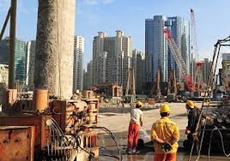China’s economy transitioning to a slower but steady growth path: IMF
17 Aug 2015
China, now the world's largest economy on a purchasing power basis, is transitioning to a new normal, with slower yet safer and more sustainable growth, IMF says.
 Growth last year fell to 7.4 per cent and is forecast to slow further to 6.8 per cent this year on the back of slower investment, especially in real estate.
Growth last year fell to 7.4 per cent and is forecast to slow further to 6.8 per cent this year on the back of slower investment, especially in real estate.
With manufacturing growth almost plateauing, China is now expected to turn to more labour-intensive service sector to boost growth.
The labour market, however, remained resilient despite slower growth. This, in turn, has supported household consumption.
The labour market has remained resilient despite slower growth, as the economy pivots toward the more labour-intensive service sector. This, in turn, has supported household consumption. Inflation is forecast to remain at 1.5 per cent, pulled down by the appreciation of the real effective exchange rate and falling global commodity prices.
Inflation is forecast to remain at 1.5 per cent, pulled down by the appreciation of the real effective exchange rate and falling global commodity prices.
China, according to the IMF review, has been following an accommodative fiscal policy and continues to be impacted by off-budget activity.
As of end-2014, augmented debt (general government plus off-budget activity) rose to around 57 per cent of GDP. Monetary policy has remained broadly neutral, as interest rate cuts have matched the decline in inflation.
Credit growth has decelerated significantly and shifted more toward conventional banking loans, as a result of stricter regulation on shadow banking. Growth in total social financing - a broad measure of funding - decelerated from the peak of 22 per cent in May 2013 to 12.5 per cent in May 2015.
China's current account surplus fell to 2.1 per cent in 2014 from the peak of around 10 per cent in 2007, and the renminbi has appreciated by about 10 per cent since last year in real effective terms. Further progress has also been made on domestic rebalancing, with consumption contributing 0.1 percentage points more to GDP growth than investment in 2014, and labor income gaining a larger share in GDP.
The slowdown is in line with the government's target of around 7 per cent and reflects progress in addressing vulnerabilities, especially a moderation in real estate investment. The recent stock market correction will not also derail the ongoing adjustment to a slower yet more balanced growth path, the report says.
''The challenge now is to take the next steps to a more open and market-based economy,'' said Markus Rodlauer, IMF mission chief for China. "This will require bold structural reforms, such as moving to a more market-based financial system, improving the management of government finances, and leveling the playing field between state-owned enterprises and the private sector.
''We also believe that China can, and should, aim for an effectively floating exchange rate regime within 2–3 years,'' said Rodlauer.
IMF also said in the new mechanism for determining the central parity of the Renminbi announced by the central bank, the country should allow market forces to have a greater say in determining the exchange rate. Greater exchange rate flexibility is important for China to better integrate into global financial markets.
In its annual assessment of the Chinese economy, the IMF urges the government to push forward with structural reforms and accept lower growth in the short term to secure sustainable and stable growth in the long run - a trade-off that is worth making and in China's best interest.
The IMF noted that China is aiming to move to a more market-based financial system and monetary policy framework, including completing interest rate liberalisation and eliminating implicit guarantees, besides a planned reform of state-owned enterprises and an effectively floating exchange rate.
The Chinese authorities are also looking to strengthen the fiscal framework, including local-central government relations, the social security system, and tax policy. These reforms are welcome steps, IMF stated.






















